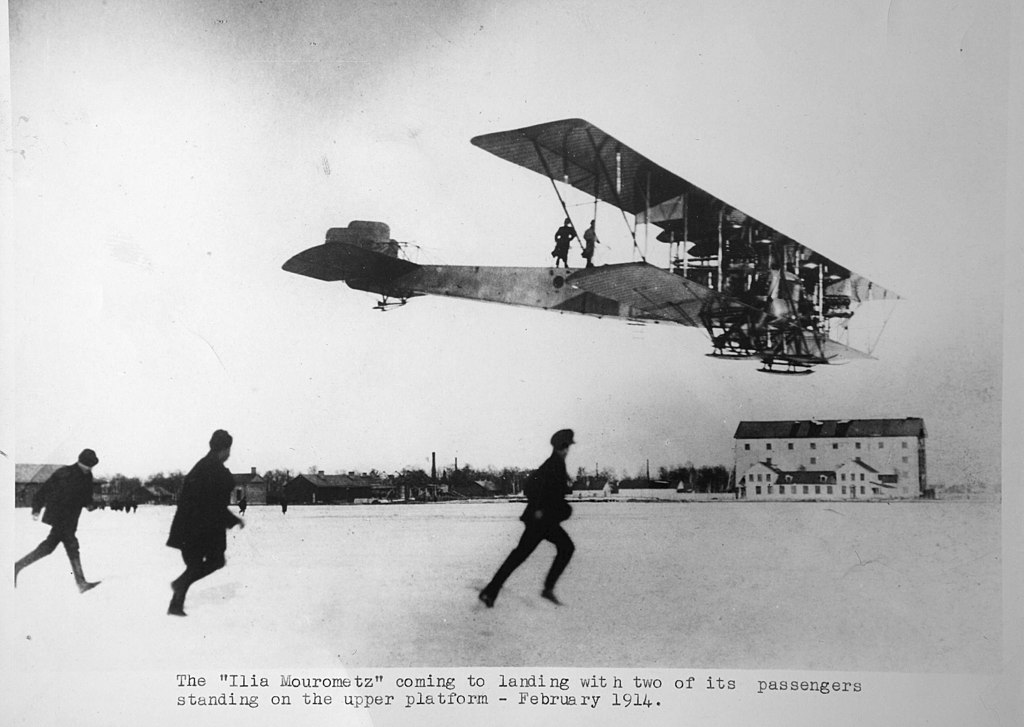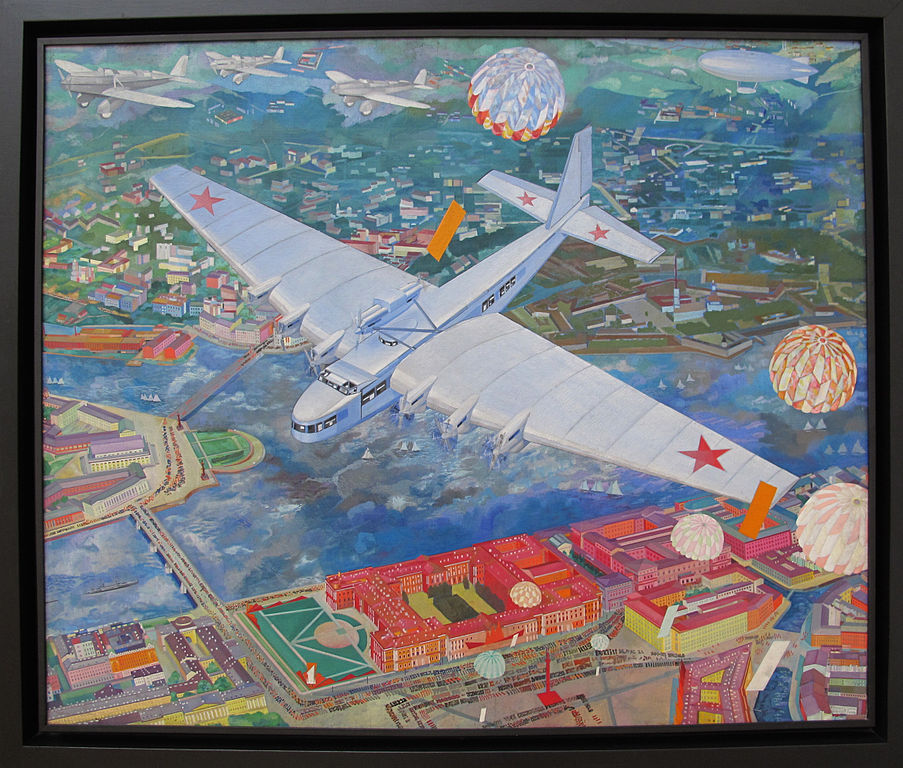The Cruel Sea:
Russia’s Giant Bomber
by Mike Bennighof, Ph.D.
July 2024
 In the world of the Second Great War, the airships of 1940 have developed to a far greater degree than was the case in our own reality, while fixed-wing airplanes are a generation or two behind. As with new ship designs, I wanted the aircraft to reflect real-world practices and to use actual airplane designs wherever possible. In the world of the Second Great War, the airships of 1940 have developed to a far greater degree than was the case in our own reality, while fixed-wing airplanes are a generation or two behind. As with new ship designs, I wanted the aircraft to reflect real-world practices and to use actual airplane designs wherever possible.
Since the aircraft of the Second Great War are roughly ten years behind those of the Second World War in terms of technology, its also a great excuse to present some of the airplanes of the early 1930’s that had been retired by the time war erupted in our own world, and so will never be seen in Second World War at Sea games.
That includes the Soviet giants of the 1930’s, the Tupolev series of heavy bombers. These really existed, and just like the Junkers G.38, they look like some kind of dieselpunk nightmare right out of a Miyazaki movie. They are, therefore, perfect for the Second Great War.
During its brief existence before the Revolution, the Imperial Russian Air Service operated a series of heavy bombers derived from an airliner designed by Igor Sikorsky and collectively known as Ilya Muromets. More than 80 combat planes were built by the Russo-Balt Works in six different models numbered S22 to S27. They were the world’s first strategic bombers, and carried a bomb load and defensive armament unmatched by any aircraft of the time.

Ilya Muromets airliner makes a landing. Passenger accommodations were limited.
Some planes took part in the Russian Civil War in the hands of several factions. Afterwards the handful of survivors reverted to the design’s original intent and became airliners, but spare parts were hard to come by and the last planes, civilian and military, were retired in 1922.
By then Sikorsky had long ago emigrated to the United States, where he would found a new company to build helicopters and become a pioneer of rotary flight. But the new Red Air Force wanted a new heavy bomber to perform the same role as Ilya Muromets, and sent out a request for proposals to its design bureaus.
Drawing on the work of Hans Junkers in Germany, Andrei Nikolayevitch Tupolev of the Central Aerohydrodynamic Institute designed a very large, twin-engined monoplane bomber known as the TB-1. The big plane had a corrugated metal skin, just like Junkers’ dream plane with huge wings and a crew of six. The Red Air Force ordered over 200 of them, including a torpedo-dropping version equipped with floats. The plane had a range of 620 miles, considered very long for the time, and could carry a ton of bombs. Once even larger bombers began to appear, the TB-1 was converted to civilian use.
Daily Content includes no AI-generated content or third-party ads. We work hard to keep it that way, and that’s a lot of work. You can help us keep things that way with your gift through this link right here.
The following plane, the TB-3, became the standard Soviet heavy bomber of the 1930’s and saw a great deal of action in the Great Patriotic War as a bomber and a transport - having been officially retired in 1939, most of the planes were well out of range of the German surprise air attacks of June 1941 and escaped destruction. The TB-3 retained the general form of the TB-1, but had four engines, twice the range and could carry five times the bomb load of its smaller cousin.
Tupolev continued to develop his design, and the prototype TB-4 added two more engines paired in a pod mounted above the fuselage. It could not match the range or bomb load of the TB-3, but instead would depend on its massive defensive firepower to carry it through to the target where the TB-3 would falter: four 20mm cannon and a full dozen machine guns in six twin turrets.
The next plane on the development tree, the huge ANT-20, never entered military service and so retained its design number (Tupolev’s initials) rather than a “Tu” designation. In 1931 the noted writer, Bolshevik opponent and virulent homophobe Maxim Gorki returned to Russia, a major propaganda coup that resulted in the renaming of a major city, many parks and streets, and the ANT-20 in his honor.

Maxim Gorki drops candy to all the good New Soviet girls and boys.
Maxim Gorki, the airplane, was the largest fixed-wing aircraft of the time and was fitted out as a flying propaganda shop with a radio transmitter, printing press and photo lab aboard as well as a library and movie theater. The plane had eight engines: six mounted in the wings, and two more in the overhead pod seen in the TB-4 prototype. Its range slightly exceeded that of the TB-3 bomber, but it had an enormous lift capacity, most of it given over to its propaganda outfit. The plane toured the Soviet Union, showing the modernity of Communism, but in May 1935 it plowed into a working-class residential neighborhood of Moscow, killing 45 people including nine on the ground.
An improved version, known as ANT-20bis, began construction the next year to take Maxim Gorki’s place. The new plane had only six engines, suppressing the pod, but matched the power output with larger engines. It entered service in 1938 and crashed in 1942, killing everyone aboard. The ANT-20bis, like the original Maxim Gorki, only served in a civilian role, making propaganda tours in the Soviet Union - well away from enemy aircraft, once the Great Patriotic War began.
 In our Second Great War alternative history, the Imperial Russian Air Service has its own version of the ANT-20bis, designated S33 (following the same sequence as the Ilya Muromets heavy bombers of the First Great War). They’re assumed to have been built by Russo-Balt Works, where Igor Sikorsky is still in charge of new aircraft designs with Andrei Tupolev as his star designer. They entered service in 1938, and the Air Service has over 200 in service with at least that many more on order. In our Second Great War alternative history, the Imperial Russian Air Service has its own version of the ANT-20bis, designated S33 (following the same sequence as the Ilya Muromets heavy bombers of the First Great War). They’re assumed to have been built by Russo-Balt Works, where Igor Sikorsky is still in charge of new aircraft designs with Andrei Tupolev as his star designer. They entered service in 1938, and the Air Service has over 200 in service with at least that many more on order.
The S33 melds together many qualities of the Tupolev-designed heavy bombers. It shares their wide wings and corrugated-aluminum skin, with six engines, all of them in the wings. It’s a huge plane, capable of carrying a massive bomb load at a great range, with the same defensive armament of the Tu-4: four 20mm cannon and a full dozen machine guns in six twin turrets. In the world of the Second Great War, only the Junkers G.38 (and licensed versions like the Mitsubishi Ki.20) can compare to the S33, which still carries the “Ilya Muromets” name.
You can order The Cruel Sea right here, right now.
Sign up for our newsletter right here. Your info will never be sold or transferred; we'll just use it to update you on new games and new offers.
Mike Bennighof is president of Avalanche Press and holds a doctorate in history from Emory University. A Fulbright Scholar and NASA Journalist in Space finalist, he has published a great many books, games and articles on historical subjects; people are saying that some of them are actually good.
He lives in Birmingham, Alabama with his wife and three children. He will never forget his Iron Dog, Leopold. Leopold feared ocean waves.
Daily Content includes no AI-generated content or third-party ads. We work hard to keep it that way, and that’s a lot of work. You can help us keep things that way with your gift through this link right here.
|
